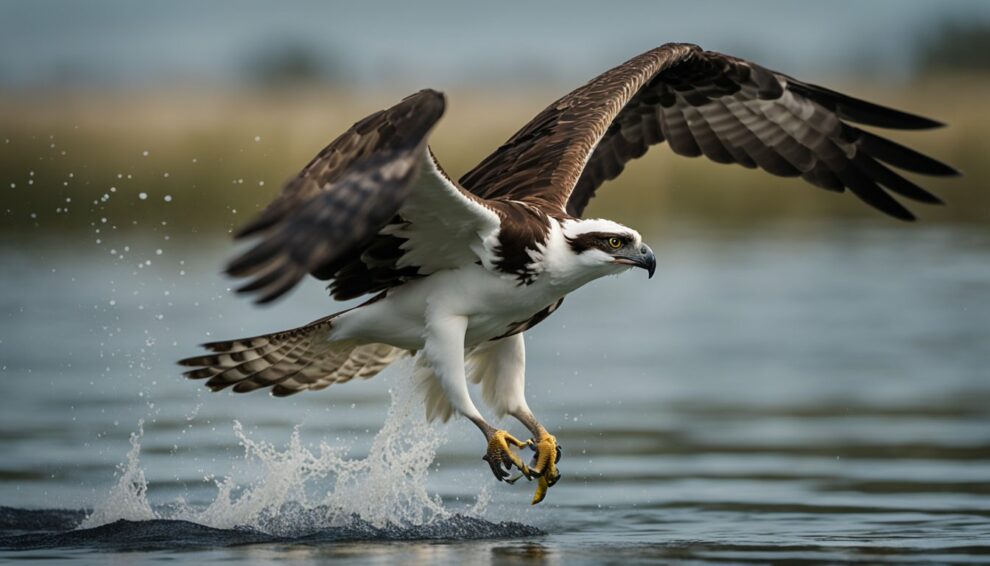The osprey is a bird of prey that excels in fishing, standing out as a prime example of nature’s skilled anglers.
These raptors have a global presence, normally found near bodies of water, which provides them with an abundant source of food.
Their fishing technique is highly specialized, making them some of the most successful fish hunters.
With sharp eyesight that can spot a fish beneath the water’s surface, ospreys dive down feet-first to snatch their prey with remarkable precision, boasting a success rate that would make even the most experienced fisherman envious.

An osprey’s unique adaptations are key to its fishing prowess.
Imagine seeing a bird that can swivel one of its toes backward to better grasp a slippery fish.
That’s the osprey for you, equipped with reversible outer toes and barbed pads on the soles of its feet to grip its catch tightly.
Even their nostrils close up to keep water out during their dive.
Can you picture them now, shaking off water easily due to their waterproof feathers, as they ascend back into the sky with their meal?
Once airborne, the osprey goes about arranging its catch headfirst, ensuring the fish is aerodynamically positioned for less air resistance.
The bird then heads back to its nest to enjoy the catch, or sometimes just to a perch for a quick meal.
Watching an osprey hunt is like witnessing a mini-drama where skill, precision, and nature’s design come together in a stunning display.
Have you ever seen anything like this in the natural world? It’s a powerful reminder of how each creature is perfectly adapted to its lifestyle.
Understanding the Osprey
The osprey soars as a master of aerial fishing, equipped with powerful physical features and behaviors fine-tuned for hunting.
This section sheds light on their adaptations, dining habits, and the places they call home throughout the year.
Physical Attributes and Hunting Adaptations
Ospreys boast a wingspan reaching up to 167 cm, with females slightly larger than males.
Their body, draped in contrasting brown upper parts and snowy white underparts, is built for the hunt.
Sharp talons with barbed pads and an outer toe that can swivel backward are some of the osprey’s specialized adaptations.
These birds exhibit exceptional eyesight, capable of spotting prey in water from tremendous heights.
When diving, the osprey’s nostrils close to keep water out, and upon ascent, they rid their feathers of water through their oily coating, ready for flight in an instant.
The Osprey’s Diet and Prey Preferences
The diet of an osprey is almost exclusively fish, with their keen eyes trained to hunt for species swimming near water surfaces.
These birds of prey favor a diverse diet but tend to capture readily available and easy-to-catch fish. Ever seen an osprey with a fish?
Chances are it’s holding it headfirst to minimize air resistance, a smart trick they’ve learned for aerodynamic travel.
Habitat and Migratory Patterns
Ospreys are at home near bodies of water—be it coastal estuaries, rivers, or lakes—that supply a steady diet of fish.
They are a global species, sighted on every continent except Antarctica.
Their migratory patterns are driven by the seasons and feeding opportunities.
Birds from colder climes head to warmer regions during winter, ensuring a constant supply of fish.
When spring arrives, they return to their breeding grounds, guided by an innate compass that has fascinated scientists and bird enthusiasts alike.
Remember the sight of an osprey plunging into the water?
That’s a migratory bird making its routine stop to refuel before continuing its impressive journey across continents.
The Art of the Dive

When an osprey circles above the water, every movement is a tactical decision, leveraging the wind and water to its advantage as it prepares for an impressive dive to catch fish.
Mastery of Wind and Water
The osprey’s command of flight under varied atmospheric conditions is a spectacle.
Its wings adapt to changing wind currents providing lift and minimizing wind resistance, crucial for maintaining the energy needed during a hunt.
As it soars, it aligns its body to turn into a living missile, streamlining itself to plunge into the water with minimal splash.
Precision in the Hunt
It’s all about timing and accuracy. An osprey can spot a fish from a height of 30 to 100 feet, watching it with intense focus.
In that critical moment, the osprey judges the depth and speed of the fish, calculating the angle of descent.
Did you know that their eyesight is so sharp, they can adjust for the refraction of light in water, allowing them to pinpoint their prey’s exact location?
Talons and Technique
The osprey’s feet are its prized tools for fishing. Each talon is curved and razor-sharp, perfect for piercing and clutching slippery fish.
They hit the water feet first, talons outstretched to grasp their target.
Curiously, they have a reversible outer toe that helps to hold the catch tightly.
Once the fish is secured, they’ll rise from the water, shaking off excess droplets, and take to the skies with a fresh meal in tow.
Did you ever notice how they position their catch forward to reduce drag while flying? Now that’s smart!
Life Beyond Fishing

The life of an osprey isn’t all about soaring and swooping to catch fish.
These majestic birds also partake in intricate behaviors related to nesting, play a role in conservation efforts, and hold significant places in cultural stories.
Breeding and Nesting Habits
Ospreys are monogamous birds, often forming long-term bonds with their mates.
During the breeding season, they engage in an elaborate courtship display that includes aerial acrobatics and calls.
The female typically lays 2 to 4 eggs which both parents help incubate.
Nesting platforms have become essential, provided by nature enthusiasts and conservationists, to give these birds safe and secure sites for raising their young.
Volunteers may be involved in constructing these man-made platforms, which imitate the tall, isolated trees ospreys favor for their nests.
Osprey Conservation Efforts
Conservationists have gone to great lengths to protect the future generations of ospreys.
Many conservation efforts focus on habitat protection and the construction of nesting platforms to counter habitat loss.
These efforts have been critical in the resurgence of osprey populations, showcasing the power of concerted human intervention in preserving nature’s splendor.
The health of osprey populations is also an indicator of water quality, as these birds rely on an abundance of fish to thrive.
Cultural Significance of Ospreys
Ospreys have captured human fascination for centuries, embodying freedom and prowess in many cultural stories and emblems.
They are seen as symbols of clarity and vision, due to their exceptional eyesight. In some cultures, seeing an osprey is considered a good omen.
Nature lovers and birdwatchers share tales of these graceful hunters, engaging future generations in the rich tapestry of life weaving through sky and water.
Frequently Asked Questions

In this section, we’ll uncover some of the most interesting aspects of how ospreys catch their fishy meals, from their unique body adaptations to their precise fishing tactics.
What special features help ospreys in their fishing pursuits?
Ospreys have several physical adaptations that aid them in hunting.
Their reversible outer toes and sharp talons are perfect for seizing slippery fish, while the barbed pads on the soles of their feet enhance their grip.
Even their nostrils are specially designed, closing up to keep water out when they dive.
How do ospreys detect and dive for fish in the water?
These birds of prey have extraordinary vision that allows them to spot fish from above.
An osprey will hover over the water, lock onto its target, and plunge feet first to snatch the fish out of the water.
It’s a breathtaking display of precision and agility.
Can you describe the typical hunting sequence of an osprey?
When hunting, an osprey will scout from a high perch or circle high in the air above the water.
On spotting a fish, the osprey folds its wings and dives steeply downward, hitting the water feet first.
After capturing the fish, it takes off again, usually shaking water from its feathers as it rises.
What time of day are ospreys most likely to go fishing?
Ospreys usually prefer to hunt during the lower light conditions of dawn and dusk.
This timing takes advantage of fish that are closer to the surface, making them easier to spot and catch.
How do ospreys adjust their flight for successful fishing?
Ospreys are expert fliers, adjusting their wingbeats and flight pattern to maintain a stationary position over the water before diving.
This hawk-like behavior gives them the necessary stability to zero in on their prey before the dramatic plunge.
What role do osprey talons play in catching their aquatic prey?
The talons of an osprey are critical in fishing success. Once an osprey hits the water, it uses its strong, curved talons to grab the fish.
The talons are designed to lock in place, ensuring that the fish cannot easily wriggle free as the osprey ascends back to the sky.









